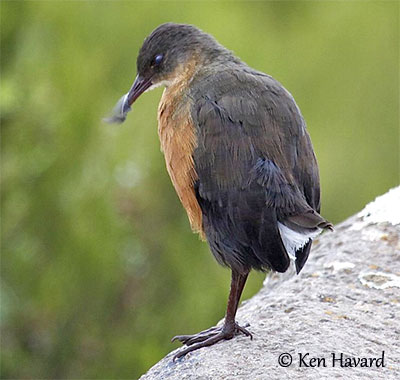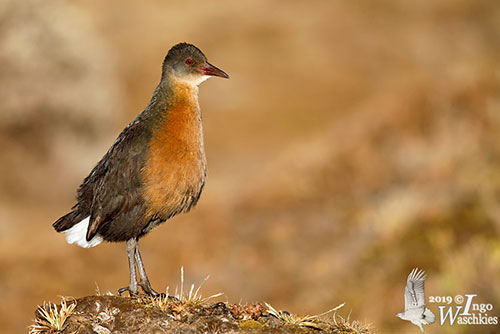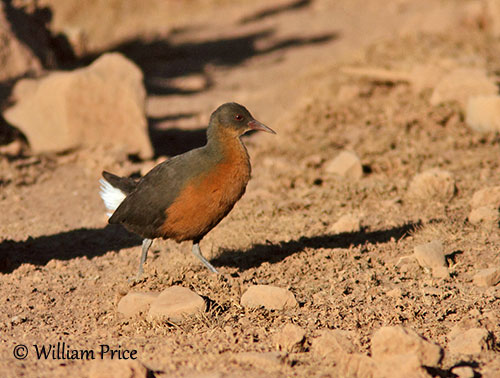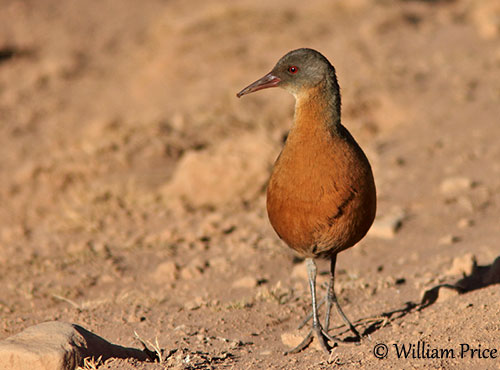
REPRODUCTION OF THIS SPECIES:
The laying takes place between March and October.
The Rouget’s Rail nests on the wet ground, among rushes or in rushes over water, or in grass tussocks. The nest is a “cushion” or a shallow cup-shaped structure made with dead rushes or grass. It is a solitary nester.
The female lays 4-8 oval, creamy-white to white eggs with buff wash and darker fine markings. The incubation is mainly performed by the female, but the male probably helps. The duration is unknown.
The chicks are fed by both parents, but the young remain in family group until they are fully grown.
PROTECTION / THREATS / STATUS:
The Rouget’s Rail is widespread in Ethiopia but much less common in Eritrea. It is confined in highlands in both regions.
This species is affected by degradation of the habitat caused by intensive grazing in wet pastures, making these areas unsuitable for the rails that need vegetation. Grasslands are converted to cultivated fields and the species is also vulnerable to droughts. But destruction and modification of the habitat are the major threats.
The population is estimated at less than 10,000 individuals, roughly rounded to 1,500/7,000 mature individuals. This population is declining.
The Rouget’s Rail is currently listed as Near Threatened.
Fr: Râle de Rouget
Ang: Rouget’s Rail
All: Rougetralle
Esp: Rascón Etíope
Ita: Rallo di Rouget
Nd: Rougets Ral
Sd: etiopisk rall
Photographers:
Ken Havard
My Bird Gallery & Flickr gallery 1 & Flickr gallery 2
William Price
PBase-tereksandpiper & Flickr William Price
Ingo Waschkies
Bird Photography
Text by Nicole Bouglouan
Sources:
HANDBOOK OF THE BIRDS OF THE WORLD Volume 3 by Josep del Hoyo-Andrew Elliott-Jordi Sargatal - Lynx Edicions - ISBN: 8487334202
RAILS - Barry Taylor and Ber Van Perlo - Pica Press - IBSN 1873403593
Birds of the Horn of Africa: Ethiopia, Eritrea, Djibouti, Somalia and Socotra Par Nigel Redman, Terry Stevenson, John Fanshawe – Helm Fields Guides – Editeur: Bloomsbury Publishing, 2010 – ISBN: 1408135760, 9781408135761
BIRDS OF AFRICA SOUTH OF THE SAHARA by Ian Sinclair and Peter Ryan - Princeton University Press Princeton and Oxford - ISBN: 0691118159
The Cornell Lab of Ornithology - Birds of the World
Selamta - Endemic Birds of Ethiopia
Rouget’s Rail
Rougetius rougetii
Gruiformes Order – Rallidae Family
INTRODUCTION:
The Rouget’s Rail is monotypic and the only member of the genus Rougetius. It occurs in the highlands of Ethiopia and Eritrea where it frequents marshy areas at high elevations, between 1,500 and 4,100 metres. But it may occur in drier ground too, usually in well vegetated parks and gardens.
This species feeds on aquatic and terrestrial insects, snails, crustaceans, earthworms and seeds. It forages among grass or in mud in shallow water. It is monogamous and both adults share the nesting duties.
The Rouget’s Rail is threatened by degradation of the habitat through intensive grazing and conversion of grasslands to cultivated fields. The species is currently listed as Near Threatened.
The name of this rail comes from the rufous-orange colour of the underparts.
DESCRIPTION OF THE BIRD:
Biometrics:
Length: 30 cm
The Rouget’s Rail has unstreaked olive-brown upperparts, whereas underparts are cinnamon-rufous, contrasting with the conspicuous white undertail-coverts. The lower flanks are dark olive-brown. The chin is whitish and the throat is pale cinnamon.
The bill is reddish. The eyes are reddish-chestnut. Legs and feet are purplish-red.
Male and female are similar.

The juvenile is not described, but the immature is paler than adults with duller plumage. The crown is dark brown, but face, chin and throat are grey.
The blackish bill has dull red base. The eyes are brown. Legs and feet are brownish-red.
RANGE:
The Rouget’s Rail is endemic to Abyssinian highlands, from Eritrea S through Ethiopia.
HABITAT:
The Rouget’s Rail is restricted to highlands, between 1,500 and 4,100 metres of elevation. It usually frequents marshy habitats in grasslands and moorlands. It occurs at the margins of pools and streams, among grass, sedges, reeds and bushes, and also in wetlands, both seasonal and permanent, and other types of wet habitats with vegetation.
This species is known to adapt to artificial habitats such as meadows, lawns, hedges and thickets in parks and gardens, sometimes very close to human habitations.
CALLS AND SONGS: SOUNDS BY XENO-CANTO
The Rouget’s Rail gives a loud, ringing and repeated “wreeeeee-creeeew” in the morning and the evening throughout the year, used as territorial and advertising call.
Two or more birds may call together, and both mates usually call side by side.
In aggression, they give a sharp, low-pitched “kak”, also a repeated “ke-ke” in extreme aggression, and a rapid, high “kikikikikiki” followed by a repeated “krrr”. It also produces various grunts and growls. The alarm call is a clear, piercing “dideet” or “di-dii”.

BEHAVIOUR IN THE WILD:
The Rouget’s Rail feeds on a wide variety of food items including earthworms, crustaceans, small snails, aquatic and terrestrial insects (Coleopterans) and seeds.
It may forage in various areas such as dry or flooded grass, sedges and generally marsh vegetation, also on bare mud, in ditches and in shallow water.
It forages by walking slowly with long strides. Invertebrates are taken on bare ground and short grass, mud and water, but the rail probes the ground and the leaf litter and examines bark crevices to disturb insects, while foraging under trees and bushes. It skulks through grass tussocks while searching for prey.
It is known to hop from stone to stone, and even dive into the water and appear again some metres away, while foraging in streams and rivers.
Compared to most rails, the Rouget’s Rail sometimes stands in open area, but it often moves quickly through the tall grass while its tail is raised, displaying the white undertail-coverts. This behaviour often allows to discover and to observe this species.

Male and female perform chases during which both move in crouching posture with the head stretched out while neck and tail are horizontal. During this display, the male runs with the wings slightly drooped, and pecks at female’s head and neck. When the female is receptive, she crouches and copulation occurs.
The chases are accompanied by calls, a gulping “gug-gug-gug” and other squeaky, rattling and growling notes.
The members of a pair often forage with immatures, and also rest and preen standing side by side. This species may live in family groups of 3 to 10 birds.
From an observation, a chick was seen with ten adults, suggesting that co-operative breeding may exist in this species. But more information is required. Usually, the Rouget’s Rail is described as monogamous with permanent pair-bonds.
The Rouget’s Rail is sedentary and no movements are observed.
Like most Rallidae species, it is mainly terrestrial and moves by walking, jumping, hopping and climbing among grass tussocks and sliding down the vegetation. When alarmed, it runs with raised head and tail.
